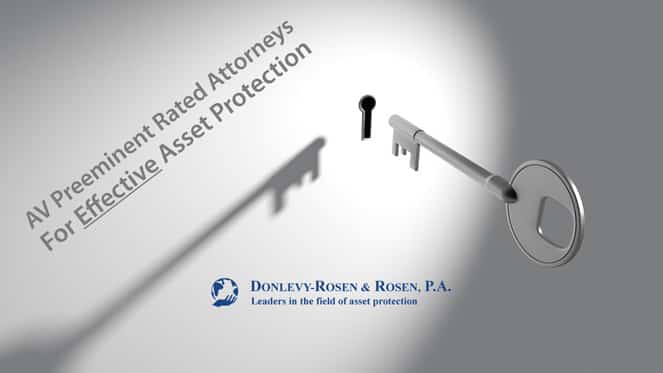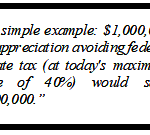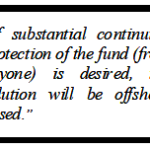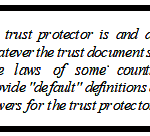Special Protective Measures Required: For Retirement Plans, Real Estate, and Accounts Receivable
Volume XI, Number 3 – November 2002
INTRODUCTION
We have often stated that because we cannot always expect fair treatment from the U.S. court system and because the system is often unpredictable, that the key to truly effective asset protection planning is to remove the ability of any United States court to disrupt the planning (i.e., reach the assets).
Where an offshore trust has been properly structured and implemented, and is holding cash and marketable securities offshore (at a time when a creditor is seeking to collect a judgment), it will be impossible for any creditor to reach those assets (even the U.S. government is 0-2!).
Contrast that with an offshore trust owning U.S. real estate (or any other asset which cannot be moved offshore): a U.S. court could simply disregard the offshore trust ownership, and record a judicial deed on the public records, transferring the property back to the settlor of the trust (thereby making that property available to his or her creditor). Similarly, retirement plans require special protective measures.
FIXED ASSETS
So, how do we go about protecting real estate, accounts receivable, equipment, and similar immovable assets (in this newsletter, we’ll call these “fixed assets”)? We have to make such assets unattractive to the creditor – not worth his trouble to go after. How do we make such assets unattractive to the creditor? By removing their value.
How do we remove their value? By encumbering them (using the asset as collateral for a loan from an unrelated lender). OK. Once we have pledged the asset as collateral for a loan, are the loan proceeds reachable by the creditor? They would be, unless the loan proceeds have been protected by depositing them along with the client’s other liquid assets in the client’s offshore trust.
Remember: The loan is made by a lender unrelated to the client, and the U.S. Constitution prohibits a U.S. court from ignoring the fact: A stranger has entered into a fair value transaction with the client, and that stranger has a property interest (mortgage lien) which cannot be taken away.
With this type of loan structure, anyone searching the public records to see what the client owns would find the client’s properties AND significant liens against such properties (i.e., little or no value to go after). Fine tuning such a loan structure requires that we use an offshore lender, which is not an offshore bank, in order to avoid U.S. withholding tax on the interest paid on the loan. The loan proceeds must, of course, be held in the offshore trust structure in a suitable offshore financial institution to avoid seizure by any U.S. court.
What type of criteria should we consider in selecting an offshore financial institution for asset protection purposes? In addition to customary factors such as financial condition and stability, the offshore financial institution must not have any U.S. branch, because, if the offshore financial institution did have a U.S. branch, a U.S. court could exert some type of pressure or influence on that U.S. branch to the detriment of the client and the protective structure.
The use of an offshore lender in this protective loan structure is not essential, but certain offshore loan facilities are available which are superior to those normally available from U.S. banks (e.g., “interest only” loans, higher loan to value ratios, etc.). The loan structure described above can be implemented by an individual client who directly owns fixed assets, or where such assets are owned by an LLC (limited liability company) which is wholly-owned by the client’s offshore trust, by that LLC.
Where the client’s business owns significant accounts receivable, real estate, and/or equipment, it is appropriate for that business entity to establish its own offshore trust to hold the loan proceeds as described above.
BOTTOM LINE
There is no other way to effectively protect fixed assets; as long as there is asset value in the U.S., a court can figure a way to get at it.
WARNING
Some planners, especially in Florida, utilize a loan structure to protect fixed assets which involves protecting the loan proceeds by purchasing an annuity or life insurance contract (the “contract”; both of which enjoy a limited exemption from creditors in Florida) and distributing the contract to the owners of the business as “non-taxable” deferred compensation (non-taxable because the continued ownership of the contract by the business owner is allegedly subject to a “substantial risk of forfeiture” if the owner leaves the business or loses his/her professional license).
This plan is very risky from two perspectives: it is almost certain that the “tax-free” distribution of the contract will not be tax free (because the IRS will not respect the contrived “risk of forfeiture” for a closely-held business) and the ultimate protection depends upon a U.S. court upholding the referenced exemption (which can and has been successfully attacked several times). Finally, the interest paid on the loan will not be deductible (adding to the cost of the plan).
PROTECTING RETIREMENT PLANS
In 1992, after the U.S. Supreme Court decided Patterson vs. Shumate (See, APN, Vol. I, No. 2, Sept. 1992), we thought the issue of qualified plan protection had been settled (i.e., that such plans were protected, period).
Beginning almost immediately after the Supreme Court decided that case, lower courts began to chip away at the decision, creating exceptions and limitations to the absolute protection of qualified retirement plans. One court even said that the fact that the IRS had determined a plan to be qualified did not bind the court, and that it could take a hindsight second look at qualification. Where do we stand today?
Is your pension plan protected? If you work for General Motors and don’t own a controlling interest in the company, your pension benefits are probably protected. If you are an owner of a small business, your pension benefits may not be protected. What can you do? The answer: take matters into your own hands.
Following the asset protection rule of “removing the ability of any U.S. court to disrupt your planning”, protecting retirement plan assets can be accomplished by causing the retirement plan to establish a single member offshore limited liability company governed by properly structured documents containing special protective provisions.
The retirement plan contributes (transfers) all of its assets to the LLC in exchange for a 100% ownership interest (member interest) in the LLC, leaving the plan directly holding only a member interest in the offshore LLC. As long as no significant litigation threat exists, the LLC assets can continue to be held at the same U.S. financial institutions where they previously resided, managed by the same investment advisor(s), and, the trustee of the pension plan (probably you) can be the LLC co-manager, with direct signature control over the cash and securities as before.
In the event of a creditor attack seeking to reach the retirement plan assets, the offshore co-manager of the LLC would, pursuant to the LLC operating agreement, remove the U.S. co-manager and relocate the LLC assets to a suitable offshore financial institution (see discussion above for criteria to be considered in selecting an offshore financial institution).
SUMMARY
At this point, the retirement plan assets are held at an offshore financial institution, but they remain invested in the same securities and managed by the same investment advisor as they were before. Couldn’t a U.S. court force the LLC owner (the retirement plan) to turn over the LLC assets? No, because the offshore LLC manager (now in control of the assets) is only permitted to act when the LLC owner (the retirement plan) is giving directions voluntarily – without any U.S. court interference.
To be certain that your qualified retirement plan assets will be available to you for your retirement: take matters into your own hands – do not depend on a U.S. court to follow the letter of the law and protect your assets.
RESULT
The plan assets are beyond the reach of any U.S. court and are thus absolutely protected.
Contact us to get answers to your asset related questions, and we’ll explain how to get the right type of asset protection. Call 305-447-0061



















Connect
Connect with us on the following social media platforms.